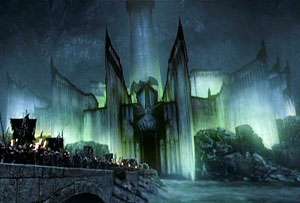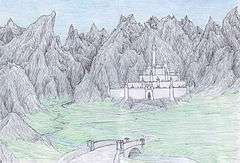Minas Morgul
| Minas Morgul | |
|---|---|
|
Artist´s depiction of Minas Ithil | |
| J. R. R. Tolkien's legendarium location | |
| Other name(s) |
Minas Ithil, The Dead City, The Tower of Sorcery |
| Type |
Fortified city of the Nazgûl, Former eastern city of Gondor |
| Ruler | Witch-king of Angmar |
| First appearance |
The Two Towers, The Return of the King |
| Location | Ithilien, on the edge of Mordor |
| Lifespan | Ca. S.A. 3320 – T.A. 3020 |
| Founder | Isildur |
Minas Morgul ([ˈminas ˈmorɡul]. Sindarin: Tower of Black Sorcery), also known by its earlier name of Minas Ithil (Sindarin: Tower of the Rising Moon), or in its full name Minas Ithil in the Morgul Vale, is a fictional fortified city in J. R. R. Tolkien's Middle-earth.
Etymology
Minas Ithil was also called the Tower of the Moon, the Tower of the Rising Moon, and the Moon-tower.[1] Minas Morgul was also called the Dead City and the Tower of Sorcery.[2]
In Tolkien's fictional elvish language, Sindarin, Minas Ithil means "Tower of the Moon"[1] and Minas Morgul means "Tower of Black Sorcery."[2] The word minas means "tower." The word ithil is a poetic name for the Moon from sil or thil meaning "shine with white or silver light." The word morgul means "black sorcery" or "black arts." The element mor means "black, dark" and gûl means "sorcery, magic"[3] from the stem ngol- (Quenya cognate nólë) meaning "long study, lore, knowledge."[4]
History
Second Age
After the destruction of Númenor, the escapees landed in Middle-earth where they founded realms-in-exile. The sons of Elendil (Isildur and Anárion) landed in Gondor, and Isildur was assigned its eastern province of Ithilien. There he built the city of Minas Ithil on the south side of a pleasant valley in the mountains bordering Mordor. (At the same time Anárion built the twin city of Minas Anor further west across the Anduin. The brothers had their thrones side by side in Osgiliath, the first capital of Gondor.) Isildur planted a sapling of the White Tree Nimloth outside his home in Minas Ithil, and one of the seven palantíri was kept in the tower. The city's white marble walls, buildings, and tower were designed to catch and reflect the moonlight, and shone with a soft silver luminescence.
Sauron had survived Númenor's destruction, but his return to Mordor was not known until he attacked the exiles of Númenor. The Dark Lord's forces first struck and captured Minas Ithil in S.A. 3429.[1] Though the White Tree was burned, Isildur and his family managed to escape down the Anduin with a seedling, seeking his father Elendil. The city was later retaken, and Elendil, Isildur, Anárion proceeded north to assault Mordor via the Morannon. In the meantime Isildur's younger sons Aratan and Ciryon were left to garrison Minas Ithil, in order to intercept Sauron if he attempted to escape from Mordor to the west.
When the Last Alliance defeated Sauron in S.A. 3441, Minas Ithil was restored as a city/fortress. Isildur elected not to replant the White Tree at Minas Ithil, instead he planted the seedling of the White Tree at Minas Anor in memory of his brother Anárion, who had been slain during the War. Then Isildur departed to take up the rule of his father's kingdom in Arnor. Minas Ithil and the rest of Gondor was now under the rule of Anárion's son Meneldil.
The War of the Ring and the Fourth Age

During the War of the Ring, Minas Morgul continued to act as the base of operations for the Witch-king and was a major garrison and forward base for Sauron's forces. The army of orcs and trolls that attacked Osgiliath and besieged Minas Tirith came from Minas Morgul.
It seems that at some point the orcs of Minas Morgul became isolated from those of the greater force of Mordor, utilizing not the Eye of Sauron as an emblem, but a skeletal crescent moon.[5] It is possible that there was a difference even in breeds of orc (as suggested in Peter Jackson's adaptation), but their leaders (Gorbag) shared time with other orcs from Mordor proper. The strain between them and the standard "Mordor orcs" at Cirith Ungol was critical in the quest to destroy the Ring of Power.
As the Army of the West made their way past Minas Morgul to their last stand at the Morannon, they destroyed the bridge leading to the Morgul Vale and set its fields aflame. Aragorn's forces met no opposition from the Tower as the city's entire garrison had been killed at the Battle of the Pelennor Fields. Prince Imrahil of Dol Amroth had proposed to attack Mordor via Minas Morgul but others feared that the evil in the valley would drive the men of Gondor mad. Gandalf also reasoned that the Ring-bearer would go through Morgul to reach Mount Doom, thus it was preferable not to draw attention to Morgul by attacking it.
After the War of the Ring, when Aragorn was crowned as King Elessar, he made Faramir the Prince of Ithilien. Faramir made his abode in the Emyn Arnen, southeast of Minas Tirith, and ruled from there with his new bride, Éowyn. At his coronation, King Elessar also decreed that Minas Ithil in the Morgul Vale be utterly destroyed and cleansed, and no man would be allowed to live there for seven years, and maybe more, depending on the evil influence of the haunted city. It has not been made known whether Minas Ithil and Osgiliath were ever rebuilt, as the major population of Ithilien became based around Emyn Arnen.
Portrayal in adaptations

The city is featured in The Lord of the Rings film trilogy directed by Peter Jackson, most prominently in The Lord of the Rings: The Return of the King. In The Lord of the Rings: The Fellowship of the Ring, the Nazgûl can be seen exiting from Minas Morgul as they ride towards the Shire to pursue the One Ring. The Staircase and Tower of Cirith Ungol, and Shelob's Lair were all designed by John Howe, with the Morgul road using forced perspective into a bluescreened miniature.
Unlike Minas Tirith, official artwork of Minas Morgul is extremely rare and inconsistent, which gave Howe considerable liberty in designing the city for the film. Howe's design of Minas Morgul was inspired from the experience of having wisdom teeth pulled out: in the same way, the Orcs have put their twisted designs on to a former Gondorian city.[6]
Cirith Ungol was based on Tolkien's design, but Richard Taylor felt it was "boring", and redesigned it with more tipping angles.[7] The interior set, like Minas Tirith, was built as a few multiple levels that numerous camera takes would suggest composed a larger structure.[8] The miniature was sprayed with phosphorescent paint and lit from below with black lights to create its unearthly glow.
References
- 1 2 3 "Minas Ithil". Encyclopedia of Arda. Mark Fisher. 23 October 2004. Retrieved 8 March 2012.
- 1 2 "Minas Morgul". Encyclopedia of Arda. Mark Fisher. 8 February 2004. Retrieved 8 March 2012.
- ↑ Hammond, Wayne G.; Scull, Christina (2005). The Lord of the Rings: A Reader's Companion. Houghton Mifflin. p. 233. ISBN 0-618-64267-6.
- ↑ Tolkien, J. R. R. (1977), Christopher Tolkien, ed., The Silmarillion, Boston: Houghton Mifflin, "Appendix", ISBN 0-395-25730-1
- ↑ Tolkien, J. R. R. (1954), The Two Towers, The Lord of the Rings, Boston: Houghton Mifflin (published 1987), Book IV Ch. 8, The Stairs of Cirith Ungol: "Two liveries Sam noticed, one marked by the Red Eye, the other by a Moon disfigured with a ghastly face of death", ISBN 0-395-08254-4
- ↑ Big-atures (Special Extended Edition documentary) (DVD). New Line Cinema. 2004.
- ↑ Russell, Gary (2004). The Lord of the Rings: The Art of the Return of the King. Harpercollins. ISBN 0-00-713565-3.
- ↑ Designing and Building Middle-earth (Special Extended Edition documentary) (DVD). New Line Cinema. 2004.
External links
- "Fortresses & Towers". the Thain's Book.
